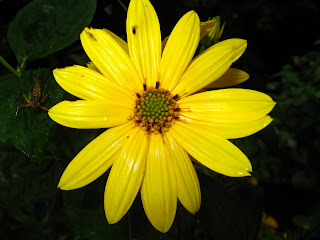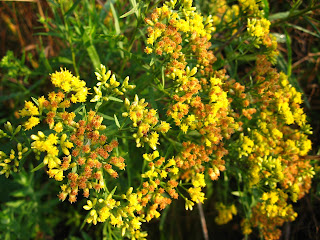
Many years ago, I saw a television interview with Mrs. Lady Bird Johnson about wildflowers. Her legacy to our country, of course, is the promotion and protection of America's wildflowers. She was showing the interviewer several different flowers, naming each species as she came to it. When she passed over one flower, the interviewer asked her, "Mrs. Johnson, what is this flower?" "Oh," she said, in her lovely Texan drawl, "that's a DYF." "A DYF?" the interviewer questioned. "Yes," she said, "a Damned Yellow Flower."
I was young enough that I was fascinated by any cursing, even mild curse words, and unlike today, swear words were very rarely heard on TV. Mostly, it came as a huge shock to me to hear the word "damn" come out of this very classy lady's mouth. It blew me away.
It wasn't until much later that I realized how true her words are. Just as sparrows are relegated to the group "Little Brown Jobs" and roundly cursed by all but a few enthusiasts, yellow summer and fall flowers give me the same feeling of dread. "Oh, no," I mutter under my breath, "another DYF."
It's that time of year again, DYF time.
I can get the odd-shaped flowers, like Common Mullein, Verbascum thapsus.

And this one I know - Butter and Eggs, Linaria vulgaris.

I figured out this one on my own - Evening Primrose, Oenothera biennis. It is a biennial, native and found in prairies. (Susan, you should get this plant.) It is pollinated by Sphinx Moths, and the seeds are eaten by wildlife.


Here's another I sussed out all by my own-self: Bird's-foot Trefoil, Lotus corniculatus. This one's not a native; it's a perennial imported from Europe.

Its foliage reminded me of alfalfa, and it turns out, I wasn't too far off in my guess. Originally introduced as a cultivated forage crop, then planted as a cover along roadways for erosion control, it has now gone wild, and will quickly overtake areas of disturbed soil.

Like alfalfa, it's a member of the pea or bean family, as you can tell by its elongated seed pods.

But, when I get into all those yellow daisy-like plants, with their ray flowers, my eyes just glaze over. They all look the same to me. (Maybe some of these are the same, I can't tell!)
I think these are two separate plants, but I'm not sure.
Oh, wait - I know this one - Black-eyed Susan, Rudbeckia hirta. That's one down.

But, what is this thing? All I know is it was tall, like about 6 feet, and along the edge of the woods.


 Wingstem, Verbesina alterniafolia
Wingstem, Verbesina alterniafoliaThank you, Donald (the Birder) and
Keith (the Clermont County naturalist)
for this ID.
Some kind of goldenrod?

Edit: Here is the foliage for the first goldenrod: This flat-topped goldenrod is probably
This flat-topped goldenrod is probably
Lance-leafed Goldenrod.
 This flat-topped goldenrod is probably
This flat-topped goldenrod is probablyLance-leafed Goldenrod.
Some other kind of goldenrod?

What the heck is this?
 Chalk it up to just another DYF, I guess.
Chalk it up to just another DYF, I guess.Small-flowered Agrimony
thanks to Jason for the complete answer
(Click on any of the above photos to enlarge.)
More DYF notes, Aug. 24:
Thanks to comments from Donald and Jason, and an e-mail from Keith, and also because I bought yet another field guide, I have gotten some names on several of these yellow flowers. Still some questions remain, because exact species names depend on plant details I didn't capture in my photos.
More DYF notes, Aug. 24:
Thanks to comments from Donald and Jason, and an e-mail from Keith, and also because I bought yet another field guide, I have gotten some names on several of these yellow flowers. Still some questions remain, because exact species names depend on plant details I didn't capture in my photos.










10 comments:
Here are some educated guesses without going do in depth with a book:
A - Tall Coreopsis
B - Jerusalem Artichoke
Image 1842-1844 is Wingstem
Sunflower maybe Helianthus divaricatus Woodland Sunflower???
The two are goldenrods, but I don't know to species.
The very last plant looks like Agrimony.
Ha! I knew Jerusalem artichoke would be in there somewhere (not that I can identify one "on the hoof", as it were.)
Thanks, Donald, for the help. I thought A. was a coreopsis. I'm still not 100% certain of the species. I can't believe I missed Jerusalem artichoke. I should have know that one. Wingstem is new to me - Keith e-mailed me about that one, too. It was growing at Crooked Run.
The sunflower may be Woodland, but I'm still unsure about it. That flower is a bit of a cheat, since I photographed it up on Lake Erie at an OOS event last fall.
I think agrimony may be right; I'm still researching that one.
~Kathi, learnin' her DYF
I'm not much help with DYF, girl. I know sunflowers, but all other yellow jobs are a mystery.
My Mom had Evening Primrose for years until she replaced it with some monstrosity of a hibiscus. That primrose was cool....in the summer, at 9 pm every night, they bloom fast enough for you to see it!
The last one reminds me of moth mullein--could it be?
I've got a case of lunapox--my verification word!!
I've sort of been feeling the butterfly fever, I guess. Never knew it had a name!
No, Nina, it's not Moth Mullen. Here is a photo of Moth Mullen from my yard. It blooms in June.
http://katdocsworld.blogspot.com/2007
/06/beauty-is-where-you-find-it.html
~Kathi
Watch the evening primrose. They are beautiful and fascinating to behold but they will take over! I had one a few years ago, a self seed I guess. 'Oh, how pretty' so I left it. This year I must have pulled 30 plants out of the same small area in spring, and when we got back from Maine there were at least 20 more.
I'm all for native plantings and wildflower conservation but ye gads! I hate to pull any plant out, but they're crowding out my daisies, cosmos, zinnias, coreopis, coneflowers and other carefully nurtured bee/hummingbird/butterfly flowers!
I would say that from looking at my books, the first goldenrod is Canada Goldenrod Solidago canadensis and the second, which has many common names (lance-leaved and grass-leaved) is flat-topped goldenrod Solidago graminifolia
Hi, KatDoc!
I was helping JZ out with her flowers and she wondered if I could lend a hand with your yellow ones.
There are a lot of yellow things coming out at the moment and those that have been out for sometime including lots of Helianthus sp., Bidens sp., Coreopsis sp. etc. To get a lot of them down to species you need to look at things like phyllary, achene, and pappus charecteristics among other things. Foliage shots tend to help a lot with these also.
I would wager that your goldenrods are most likely Solidago juncea (Early Goldenrod), although canadensis and nemoralis are starting to flower. Many of the others are still in bud at this time of the year.
You are correct about the last one being an agrimony. It is Agrimonia parviflora Aiton a.k.a. Small-flowered Agrimony. It can usually be identified from the other species by having a greater number of leaflets per leaf than the other species in our area. The give away for it, however, is its huge, serrated stipules at the base of each leaf.
Great pictures! Keep them coming!
Jason
Thanks, Jason, for your helpful input. I appreciate your efforts in reviewing my wildflowers.
~Kathi
Post a Comment